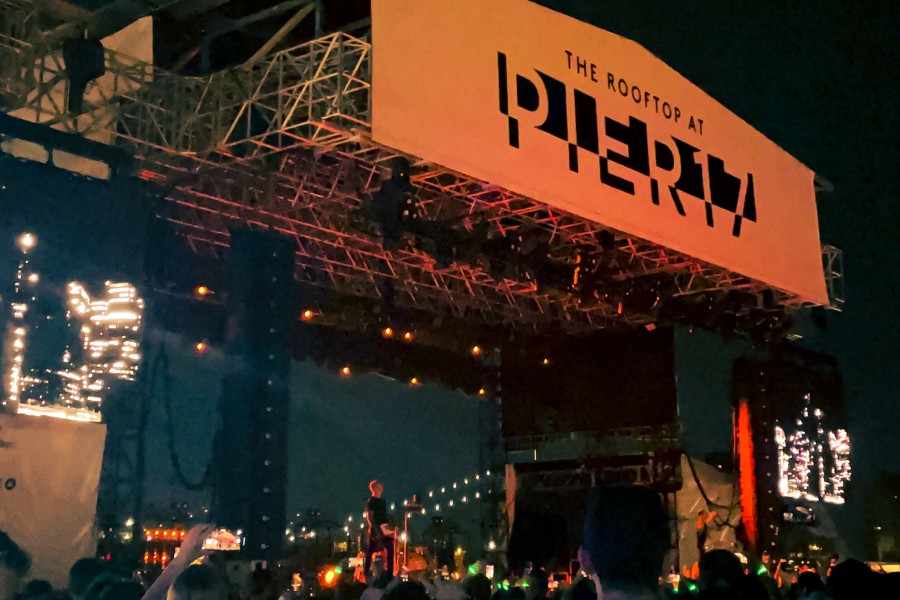The pop-punk revival: Not so simply planned
Just as people thought punk was dead, we entered three years of turmoil which brought it back to life.
Pop punk is an inclusive and mainstream evolution from the punk-rock genre that gives voice to the angst of young adults and teens. (Clara Scholl for WSN)
September 12, 2022
After three years of social and political upheaval, it’s no wonder that our popular music has a bit more angst in it. Artists such as Olivia Rodrigo, Willow Smith and Hayley Williams went from relatively unknown singers to complete superstars in 2020, using, in part, the more aggressive sound of pop punk.
With her debut album titled “Sour,” Rodrigo abruptly switches steady rhythm for raucous grunge and distortion. There is no doubt that Rodrigo’s shift to sonic turmoil resonates with the unpredictability that we feel — living through the pandemic, climate change, war and economic downfall, on top of navigating the unpredictability of young-adulthood.
This is by no means the new wave punk scene of the ’70s, which was led by bands such as Ramones, The Clash, and The Sex Pistols. It is, however, more reminiscent of the pop-punk bands of the ’90s that gained more mainstream success. Sum 41, Avril Lavigne, Blink-182 and Green Day fall into this category. It’s pop punk that leads to spontaneously dancing around your apartment and belting out each lyric with reckless abandon.
This genre of pop punk gains back what it loses to punk rock in reaction-driven, political lyrics with reliability and inclusivity. The punk rock movement was incredibly male-dominated — so much so that women-led bands formed Riot Grrrl, a punk movement that formed in the ’90s.
Pop-punk, however, brings women to the forefront. The genre has very little to do with any social movement, but its centering of teenage angst has offered women a space to be as loud and angry as they please — or, if they choose, the opposite. They are not boxed into a specific style of music in the way that pop stars typically are.
In this movement, all decades of pop-punk music are more accessible to everyone. With more non-male artists topping the charts, more people can relate to the musical style and lyricism behind each song. In doing so, the audience for the genre has widened.
Canadian pop-punk bands Sum 41 and Simple Plan have joined forces for the 21-year anniversary of “The Blame Canada Tour,” with new music and high-energy renditions of their early hits. Their recent show at Pier 17 in New York, and many of their other tour dates, completely sold out.
With the crowd-surfing, flying shoes and beach balls, the crowd was more impressive than the music. While some people dressed in all black with fishnet stockings and dark eyeliner, others wore snap-back caps and football jerseys. There were even attendees wearing pink leggings and graphic tank tops, with their hair pulled back in ponytails. The uniqueness of the crowd wasn’t limited to personal fashion choices or expression. There were families — a small child wore headphones and sat on his father’s shoulders, grabbing his mother’s arm. There were older, married couples. There was even a woman wearing nurse’s scrubs, who presumably arrived at the show after a shift at work next to a man wearing moldable elf ears.
Pop punk is punk rock’s bedazzled cousin, with a higher budget and more polish, making a comeback because of its digestibility. Whether you like this or not, keep in mind that pop punk brings new representation to a genre that has consisted mostly of heterosexual men — the resistance which brings to mind the most important themes within punk. And it’s no coincidence that pop punk’s resurgence comes at a time when teenage angst is at a high.
The diverse crowd speaks to the similar drive among everyone — at least everyone who experienced the pandemic — relating to the sound of pop punk. Within the past three years, our lives have become even more unpredictable. As young adults, we already have very little in our control, so it’s no wonder that we feel like all we can do is laugh as the world burns. That is exactly what pop-punk suggests we do.
From Simple Plan’s “I’m Just A Kid” to Rodrigo’s “brutal,” pop punk provides a relatable combination of feeling bad for yourself while also feeling disdain at being the person who’s sad or angry or heartbroken. Whether or not this is helpful, it certainly allows us to bask in teenage dread as college students and beyond.
Contact Clara Scholl at [email protected].




























































































































































